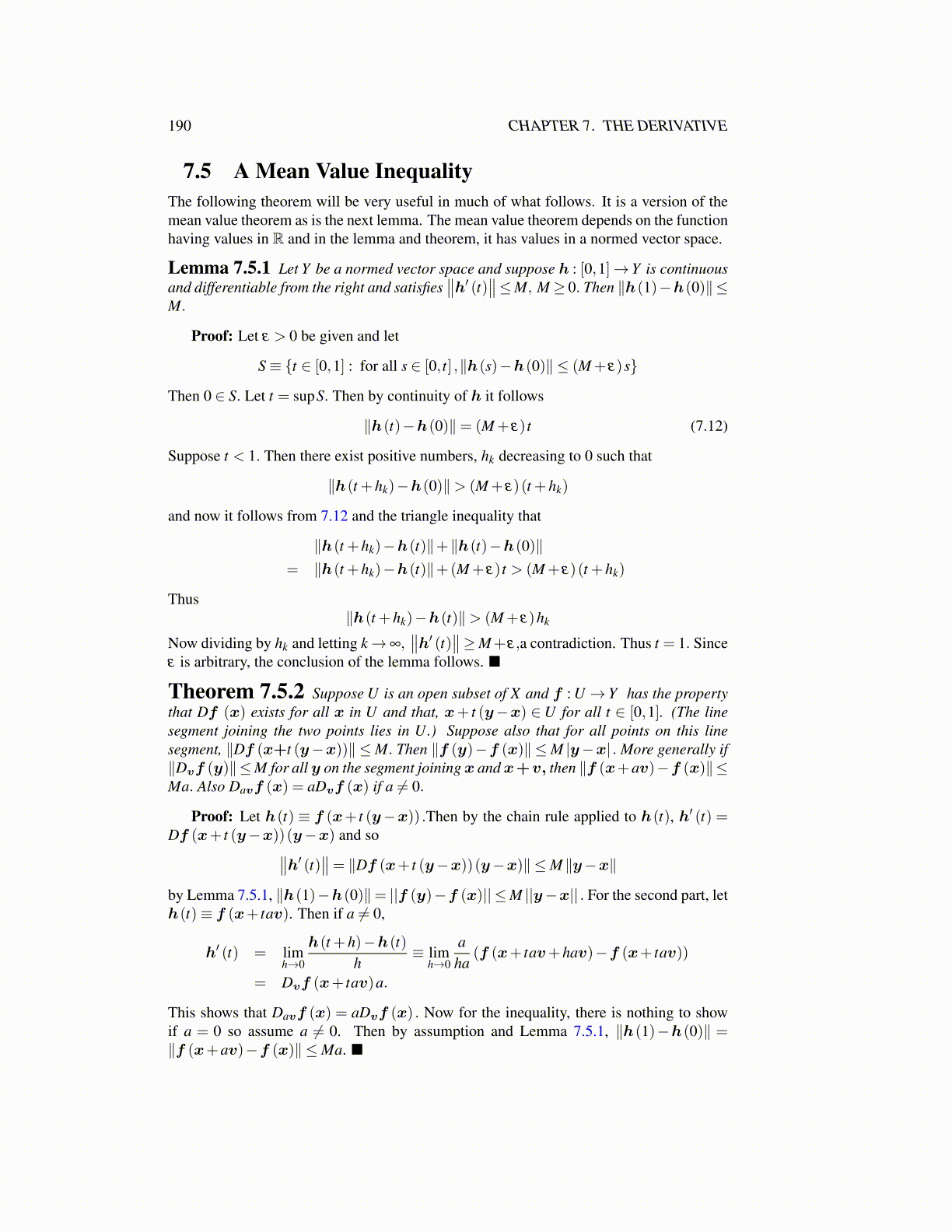
190 CHAPTER 7. THE DERIVATIVE
7.5 A Mean Value InequalityThe following theorem will be very useful in much of what follows. It is a version of themean value theorem as is the next lemma. The mean value theorem depends on the functionhaving values in R and in the lemma and theorem, it has values in a normed vector space.
Lemma 7.5.1 Let Y be a normed vector space and suppose h : [0,1]→Y is continuousand differentiable from the right and satisfies
∥∥h′ (t)∥∥≤M, M≥ 0. Then ∥h(1)−h(0)∥≤M.
Proof: Let ε > 0 be given and let
S≡ {t ∈ [0,1] : for all s ∈ [0, t] ,∥h(s)−h(0)∥ ≤ (M+ ε)s}
Then 0 ∈ S. Let t = supS. Then by continuity of h it follows
∥h(t)−h(0)∥= (M+ ε) t (7.12)
Suppose t < 1. Then there exist positive numbers, hk decreasing to 0 such that
∥h(t +hk)−h(0)∥> (M+ ε)(t +hk)
and now it follows from 7.12 and the triangle inequality that
∥h(t +hk)−h(t)∥+∥h(t)−h(0)∥= ∥h(t +hk)−h(t)∥+(M+ ε) t > (M+ ε)(t +hk)
Thus∥h(t +hk)−h(t)∥> (M+ ε)hk
Now dividing by hk and letting k→∞,∥∥h′ (t)∥∥≥M+ε,a contradiction. Thus t = 1. Since
ε is arbitrary, the conclusion of the lemma follows. ■
Theorem 7.5.2 Suppose U is an open subset of X and f : U → Y has the propertythat Df (x) exists for all x in U and that, x+ t (y−x) ∈U for all t ∈ [0,1]. (The linesegment joining the two points lies in U.) Suppose also that for all points on this linesegment, ∥Df (x+t (y−x))∥ ≤M. Then ∥f (y)−f (x)∥ ≤M |y−x| . More generally if∥Dvf (y)∥≤M for all y on the segment joiningx andx+v, then ∥f (x+av)−f (x)∥≤Ma. Also Davf (x) = aDvf (x) if a ̸= 0.
Proof: Let h(t) ≡ f (x+ t (y−x)) .Then by the chain rule applied to h(t), h′ (t) =Df (x+ t (y−x))(y−x) and so∥∥h′ (t)∥∥= ∥Df (x+ t (y−x))(y−x)∥ ≤M ∥y−x∥
by Lemma 7.5.1, ∥h(1)−h(0)∥= ||f (y)−f (x)|| ≤M ||y−x|| . For the second part, leth(t)≡ f (x+ tav). Then if a ̸= 0,
h′ (t) = limh→0
h(t +h)−h(t)h
≡ limh→0
aha
(f (x+ tav+hav)−f (x+ tav))
= Dvf (x+ tav)a.
This shows that Davf (x) = aDvf (x) . Now for the inequality, there is nothing to showif a = 0 so assume a ̸= 0. Then by assumption and Lemma 7.5.1, ∥h(1)−h(0)∥ =∥f (x+av)−f (x)∥ ≤Ma. ■